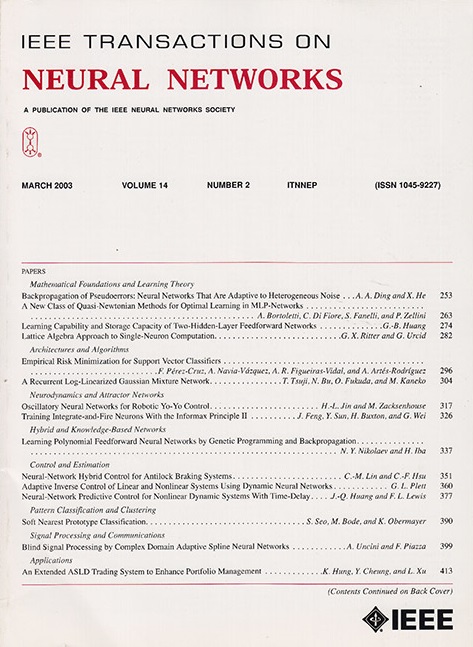具有规则泛化功能的自组织堆叠式 2 型模糊神经网络
IF 8.9
1区 计算机科学
Q1 COMPUTER SCIENCE, ARTIFICIAL INTELLIGENCE
IEEE transactions on neural networks and learning systems
Pub Date : 2025-04-01
DOI:10.1109/TNNLS.2025.3544495
引用次数: 0
摘要
2型模糊神经网络(T2FNNs)在处理非线性系统方面特别有效。然而,由于足迹不确定性(FOU)的显著重叠,它们不可避免地遭受多重共线性问题,从而导致泛化偏差。为了解决这一问题,开发了一种具有规则泛化的自组织堆叠T2FNN (RG-SOST2FNN),以提高其整体性能。首先,设计了一种具有余弦智能优先级的T2FNN融合技术。该技术利用多变量余弦相似度获得稀疏输入,选择性地叠加具有非共线性输入的多个t2fnn,以减少共线性依赖。其次,开发了一个带有规则集群生成机制的动态堆叠框架,实现了规则的单独和批量调整;然后,通过消除fou参数矩阵的奇异性,得到具有分集的堆叠结构,以缓解规则间的共线性;第三,提出了一种叠置风险缓解算法来形成模糊规则聚类。然后,利用稀疏梯度学习对frc参数进行优化,避免了共线特征的更新,减小了参数估计的方差;最后,仿真测试表明,RG-SOST2FNN在复杂系统的高多重共线性下也能达到最先进的性能。本文章由计算机程序翻译,如有差异,请以英文原文为准。
Self-Organizing Stacked Type-2 Fuzzy Neural Network With Rule Generalization
Type-2 fuzzy neural networks (T2FNNs) are particularly effective in dealing with nonlinear systems. However, they inevitably suffer from multicollinearity problems caused by the significant overlaps of the footprint uncertainty (FOU), which leads to generalization biases. To solve this challenge, a self-organizing stacked T2FNN with rule generalization (RG-SOST2FNN) is developed to boost its overall performance. First, a stacked technique with cosine smart priority is designed for T2FNN fusion. This technique employs multivariable cosine similarity to obtain sparse inputs, which selectively stacks multiple T2FNNs with non-collinear inputs to reduce collinearity dependence. Second, a dynamic stacked framework with a rule cluster generation mechanism is developed to achieve individual and batch rule adjustment. Then, a stacked structure with diversity is obtained to alleviate collinearity among rules by eliminating the singularity of the parameter matrix of FOUs. Third, a stacked risk mitigation algorithm is proposed to shape the fuzzy rule clusters (FRCs). Then, the parameters of FRCs are optimized using sparse gradient learning, which avoids the updating of collinear features to reduce the variance of parameter estimation. Finally, the simulation tests show that RG-SOST2FNN can achieve state-of-the-art performance even at high multicollinearity in complex systems.
求助全文
通过发布文献求助,成功后即可免费获取论文全文。
去求助
来源期刊

IEEE transactions on neural networks and learning systems
COMPUTER SCIENCE, ARTIFICIAL INTELLIGENCE-COMPUTER SCIENCE, HARDWARE & ARCHITECTURE
CiteScore
23.80
自引率
9.60%
发文量
2102
审稿时长
3-8 weeks
期刊介绍:
The focus of IEEE Transactions on Neural Networks and Learning Systems is to present scholarly articles discussing the theory, design, and applications of neural networks as well as other learning systems. The journal primarily highlights technical and scientific research in this domain.
 求助内容:
求助内容: 应助结果提醒方式:
应助结果提醒方式:


